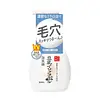What's inside
What's inside
 Key Ingredients
Key Ingredients

 Benefits
Benefits

 Concerns
Concerns

 Ingredients Side-by-side
Ingredients Side-by-side

Water
Skin ConditioningStearic Acid
CleansingMyristic Acid
CleansingPEG-8
HumectantPotassium Hydroxide
BufferingLauric Acid
CleansingGlycerin
HumectantDipropylene Glycol
HumectantAlcohol
AntimicrobialBeeswax
Emulsion StabilisingPolyquaternium-7
CI 77891
Cosmetic ColorantParfum
MaskingDisodium EDTA
PEG-90m
Emulsion StabilisingSodium Benzoate
MaskingTalc
AbrasiveSodium Metabisulfite
AntioxidantSodium Metaphosphate
BufferingAluminum Hydroxide
EmollientPEG/PPG-14/7 Dimethyl Ether
Skin ConditioningSodium Hyaluronate
HumectantSodium Acetylated Hyaluronate
HumectantSilica
AbrasiveBHT
AntioxidantSericin
Skin ConditioningCitric Acid
BufferingPotassium Sorbate
PreservativeHydrolyzed Silk
HumectantWater, Stearic Acid, Myristic Acid, PEG-8, Potassium Hydroxide, Lauric Acid, Glycerin, Dipropylene Glycol, Alcohol, Beeswax, Polyquaternium-7, CI 77891, Parfum, Disodium EDTA, PEG-90m, Sodium Benzoate, Talc, Sodium Metabisulfite, Sodium Metaphosphate, Aluminum Hydroxide, PEG/PPG-14/7 Dimethyl Ether, Sodium Hyaluronate, Sodium Acetylated Hyaluronate, Silica, BHT, Sericin, Citric Acid, Potassium Sorbate, Hydrolyzed Silk
Water
Skin ConditioningGlycerin
HumectantSorbitol
HumectantMyristic Acid
CleansingIsostearic Acid
CleansingPotassium Hydroxide
BufferingAlcohol Denat.
AntimicrobialLauric Acid
CleansingSoymilk Isoflavones
AntioxidantMilk Ferment
Skin ConditioningDecyl Glucoside
CleansingCeramide Ng
Skin ConditioningButylene Glycol
HumectantCarbomer
Emulsion StabilisingCyclodextrin
AbsorbentGlycine Max Seed Extract
Skin ConditioningPhytosterols
Skin ConditioningSodium Lauroyl Methylalanine
Hydrogenated Lecithin
EmulsifyingPhenoxyethanol
PreservativeWater, Glycerin, Sorbitol, Myristic Acid, Isostearic Acid, Potassium Hydroxide, Alcohol Denat., Lauric Acid, Soymilk Isoflavones, Milk Ferment, Decyl Glucoside, Ceramide Ng, Butylene Glycol, Carbomer, Cyclodextrin, Glycine Max Seed Extract, Phytosterols, Sodium Lauroyl Methylalanine, Hydrogenated Lecithin, Phenoxyethanol
Ingredients Explained
These ingredients are found in both products.
Ingredients higher up in an ingredient list are typically present in a larger amount.
Glycerin is already naturally found in your skin. It helps moisturize and protect your skin.
A study from 2016 found glycerin to be more effective as a humectant than AHAs and hyaluronic acid.
As a humectant, it helps the skin stay hydrated by pulling moisture to your skin. The low molecular weight of glycerin allows it to pull moisture into the deeper layers of your skin.
Hydrated skin improves your skin barrier; Your skin barrier helps protect against irritants and bacteria.
Glycerin has also been found to have antimicrobial and antiviral properties. Due to these properties, glycerin is often used in wound and burn treatments.
In cosmetics, glycerin is usually derived from plants such as soybean or palm. However, it can also be sourced from animals, such as tallow or animal fat.
This ingredient is organic, colorless, odorless, and non-toxic.
Glycerin is the name for this ingredient in American English. British English uses Glycerol/Glycerine.
Learn more about GlycerinLauric Acid is a fatty acid or lipid. About half of fatty acids in coconut oil is lauric acid.
This ingredient helps hydrate and sooth skin. As a humectant, it helps trap moisture. It also aids in cleaning and enhancing the texture of products.
Lauric acid may not be Malassezia folliculitis, or fungal acne, safe.
Learn more about Lauric AcidMyristic Acid is a saturated fatty acid. It is naturally found in milk fat. Other sources include palm oil, coconut oil, and butter fat.
Myristic Acid is an emulsifer and cleanser. As an emulsifer, it stabilizes a product by preventing ingredients from separating. Myristic Acid helps clean your skin by acting as a surfactant. It tends to gather oil and dirt on your skin to be easily rinsed away.
One study from 2021 found Myristic Acid to have anti-inflammatory properties.
Learn more about Myristic AcidPotassium hydroxide is commonly known as caustic potash. It is used to fix the pH of a product or as a cleaning agent in soap. In cleansers, it is used for the saponification of oils.
Sapnification is the process of creating fatty acid metal salts from triglycerides and a strong base. During this process, Potassium Hydroxide is used up and is not present in the final product.
Using high concentrations of Potassium Hydroxide have shown to irritate the skin.
Learn more about Potassium HydroxideWater. It's the most common cosmetic ingredient of all. You'll usually see it at the top of ingredient lists, meaning that it makes up the largest part of the product.
So why is it so popular? Water most often acts as a solvent - this means that it helps dissolve other ingredients into the formulation.
You'll also recognize water as that liquid we all need to stay alive. If you see this, drink a glass of water. Stay hydrated!
Learn more about Water